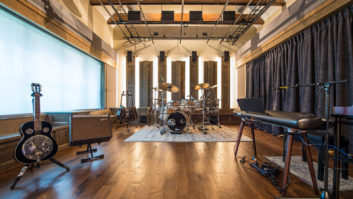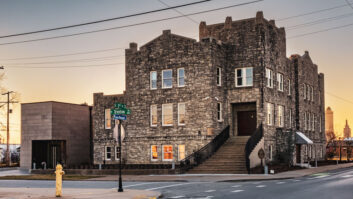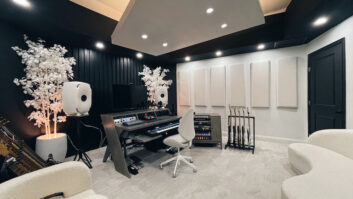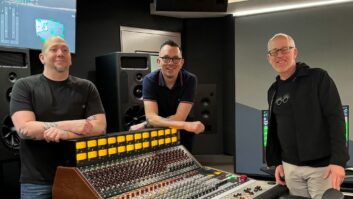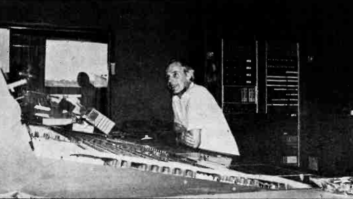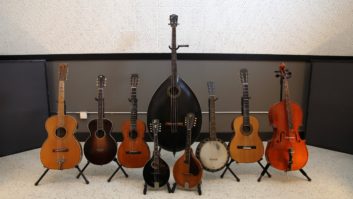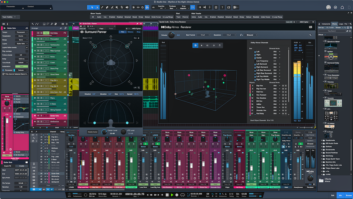The mere image of a large-diaphragm condenser microphone defines the act of mainstream studio recording on a universal scale. Though every other component in the recording chain has evolved over the years, our adopted symbol—a relatively certain size and shape of microphone based on an approximately 1-inch or larger diaphragm in an almost-always side-address body—remains. It provides lively, comprehensive, quite accurate and full audio spectrum transduction, categorically with a most complete frequency response, usually covering the full range of human hearing. As such, LDCs are especially lovely on the human voice—the proven key component of popular music—and most other complex sound sources, too.
The LDC, featuring an externally charged capacitor via “phantom power” from its preamplifier, is most often cardioid in polar pattern, the most affordable configuration in its marketplace. Yet, multi-pattern models are most flexible in use, and “tube” (or valve amplifier) models generally impart some flattering tonal artifacts. When monitored by the performing artist, LDCs are said to often inspire better takes, reinforcing the widely accepted truth that they are worthy investments, alongside the ubiquitous workhorse dynamic mics.
I absorbed a lot about specific LDCs over the past decade as the Reviews Editor for Pro Audio Review magazine. We reviewed everything we could get our hands on. Month after month, not only did I use many of these mics, I edited reviews of nearly every brand’s newly released LDC, researching and discussing each of the procured models with our contributors who had applied them in professional, real world and practical applications. I didn’t retain all the thousands of pages of the resulting facts and figures, but I did gain significant insight on the products that now define the LDC marketplace.
So without further ado, geek out with me on this “who’s who” among LDC manufacturers, as well as their latest, and greatest, hits. Among the “who’s who” are a number of manufacturers who did not introduce new models in recent years, while continuing to offer superb LDC mics—in some cases custom-built models—such as ADK, Bock Audio, Brauner, CAD, Charter Oak Acoustics, Flea Microphones, Josephson Engineering, JZ Microphones, Korby Audio Technologies, LeWilson Microphones, M-Audio, Manley Labs, Microtech Gefell, Pearlman, Peluso Microphone Lab, and Wunder Audio. Please visit their Websites to learn more about their offerings.

AKG’s most recent model is the C314 dual-diaphragm condenser, which debuted at the 2015 Musikmesse and is borne of C414 components combined with new proprietary technologies such as Overload LED Detection Display. Features include a 20dB pad, HPF and four polar patterns.

Audio-Technica’s relatively new flagship, the 50 Series, offers the cardioid AT5040, an “exceptionally large diaphragm” condenser featuring an innovative, pure-sounding four-part rectangular element.

The Audix USA SCX25A is a “lollipop” style cardioid featuring a 1-inch gold vapor capsule, impressively overbuilt machined brass housing and high-decibel handling (up to 135dB SPL).

BLUE (Baltic Latvian Universal Electronics) still offers its full historic LDC line, including the flagship Bottle—a modular system featuring nine interchangeable capsules, including a variety of LDCs—and newer LDC innovations, too.

Ear Trumpet Labs company founder Phil Graham creates his transducer artwork in Portland, Ore. In review, my colleague Rob Tavaglione says that ETL’s Mabel, a 3-pattern LDC with dual 1-inch diaphragms, “is definitively one of those rare pieces of effectively artsy engineering that inspires performances and possibly shortens lengthy days” in the studio.

InnerTUBE Audio offers the MM-2000 Mag Mic, a tube LDC that employs the body of a black, red or blue 2 D-cell Mag-lite inspired by their work with Neumann U 87 and 451 tube mic retrofits. It’s truly savvy employment of an already existing sturdy, shockproof and “acoustically dead” housing. The MM-2000 is a continuously variable patterned, 12-pound model featuring 1-inch dual diaphragms, “premium European” capsule and a hand-selected 6922 electron tube.

Recently, Rob Tavaglione and Russ Long visited Studio at the Palms in Las Vegas for a first audition/listen to Lauten Audio’s latest LDC, the Eden LT-386. Rob shares of his initial pre-review impressions: “It’s warmed by its tube and transformer; versatile thanks to its voicings and filters; and physically secure thanks to an integral, semi-permanent shock-mount.”

Vienna, Austria’s Lewitt Audio was founded by Roman Perschon, whose line of condensers is called the LCT Authentica Series, offering seven LDCs with modern features such as illuminated buttons and automated attenuation with clip detection and history settings. Two LCT Authentica models, including the flagship LCT 940 with dual FET and Tube modes, feature a unique glowing tube built into the bodies.

Marshall Electronics’ MXL microphone brand, with more than 30 LDC models, offers much value, performance and impressive component- and build-quality. In reviewing the Genesis FET LDC last year, Rob Tavaglione shared, “Bottom line, it’s clean and quick, forward but not pushy, with top-emphasis yet not bottomless. And for $400? It’s a bargain-priced, worthy choice.”

Nashville-based Miktek Audio has a rabid pro-level fan base for its premium yet reasonably priced LDC range. Two new models, C1 Cardioid FET and flagship CV3 nine-pattern Tube LDCs, are both designed and built in the U.S., available for $599 and $999 street, respectively.

David Royer’s Mojave Audio brand ships Jensen transformers and NOS (New Old Stock) tubes to a Chinese factory Royer had been working with for 15 years, where they are paired with capsules and bodies selected by David and company. The results include LDCs of amazing value that are quality-controlled, burned in, and personally listened to by David back in Burbank, post-build. To date, Mojave offers four LDCs including multipattern FET, cardioid FET, continuously variable tube, and cardioid tube models.

Hardly needing an introduction, Neumann arguably holds the record for the most famous and respected condensers in our field, continued in LDCs such as the modern-day U 87 Ai, U 47 fet, TLM 67, M 150 Tube, among others. Neumann has also provided lower price-point LDC offerings in its TLM 102 and TLM 103 cardioid-only models and innovative digital mic models via the flagship D-01 and more affordable TLM 103 D.

Russia’s Oktava was founded in 1927 and remains one of the oldest microphone brands in the world, though the company only started officially exporting its products in the mid-1990s. Presently there are four Oktava LDC models—ranging from MK-101 wide cardioid to the new MK-220, a twin-diaphragm multipattern model—currently available to the U.S. market.

Swedish manufacturer Pearl Microphones offers LDCs based on rectangular capsules; their shape allows them to be more narrow and longer, providing an unusually large capsule surface area with a low profile. Colleague Rob Tavaglione recently reviewed Pearl’s latest LDC, the Priority, noting, “The sonic differences between rectangular and circular diaphragms are indeed audible, significant and offer utility to those who have mic placement down to a science.”

Australian pro audio manufacturer RØDE’s LDCs include the exceptional-value NT1-A cardioid, a best-selling RØDE with notably low self-noise priced at $229 street, up to the Classic II, a limited edition cardioid model featuring a 6072 twin triode tube.

sE Electronics’ latest—another collaboration with the illustrious Rupert Neve—is now sE’s flagship LDC. It’s the RNT, “Rupert Neve’s first and only tube microphone,” based on a custom-manufactured, high-SPL handling capsule, and a hand-selected, low noise 12AU7 tube, paired with a nine polar-pattern floor power supply.

Sennheiser unveiled the MK Series of LDCs a few years ago. I reviewed the first model, the amazingly priced cardioid MK 4 ($299 street), finding it to be an extremely fine bargain, actually built in the company’s German factory alongside its far pricier relatives. Meanwhile, I just received the latest MK Series mic for review—the MK 8, a dual 1-inch diaphragm LDC with five polar patterns. Priced at $699 street, I can’t wait to tear into this one.

Shure released its first condenser microphone in the 1930s. However, it’s only been within the past 15 years that Shure has pursued the studio recording microphone market, with great results; the company’s KSM Series boasts some truly great LDCs at reasonable prices. Its flagship, the KSM44A ($999 street), is a multi-pattern, dual-diaphragm model with characteristics rivaling LDCs costing hundreds of dollars more.

English microphone company Sontronics offers distinctively designed, equally great-sounding LDCs. Its latest LDC is the Aria, a buzzed-about cardioid model featuring a 1.07-inch capsule and hand-selected 12AX7/ECC83 tube.

Sony offers two LDCs: the cardioid C38B and the illustrious, legendary cardioid/omni C800-G tube. At more than $11k, the wholly modern C800-G is vintage LDC priced and, if you have the budget, worth it, considering its blend of premium performance and justifiable prestige.

Soyuz Microphones’ SU-017 is a “bottle-style” cardioid model with eight optional interchangeable capsules. Based in Tula, Russia, the brand remains in the same city where Russia’s oldest continuously working microphone factory is located. Soyuz Microphones are distributed in North America by Southern California firm MV Pro Audio.

Guitar Center’s private label microphone brand, Sterling, was born of impressive pedigree. The first few models employed designs and technology developed by Aspen Pittman for Groove Tubes, all of which were quite impressive microphones for the money in the late ’90s/early 2000s. Sterling’s flagship model, the cardioid ST6050, was voiced by Grammy Award–winning engineer Allen Sides.

Telefunken Elektroakustik in South Windsor, Conn., honors its illustrious namesake by building reverent modern-day remakes of its vintage LDCs, along with new, “ground-up” offerings, too. The company’s Diamond Series features ELA M 251, U47, U48 and C12 models, while the R-F-T line features unique designs based on more affordable amalgamations of the designs.
Strother Bullins is NewBay Media’s Reviews Editor, AV/Pro Audio Group. Reach him at [email protected].
